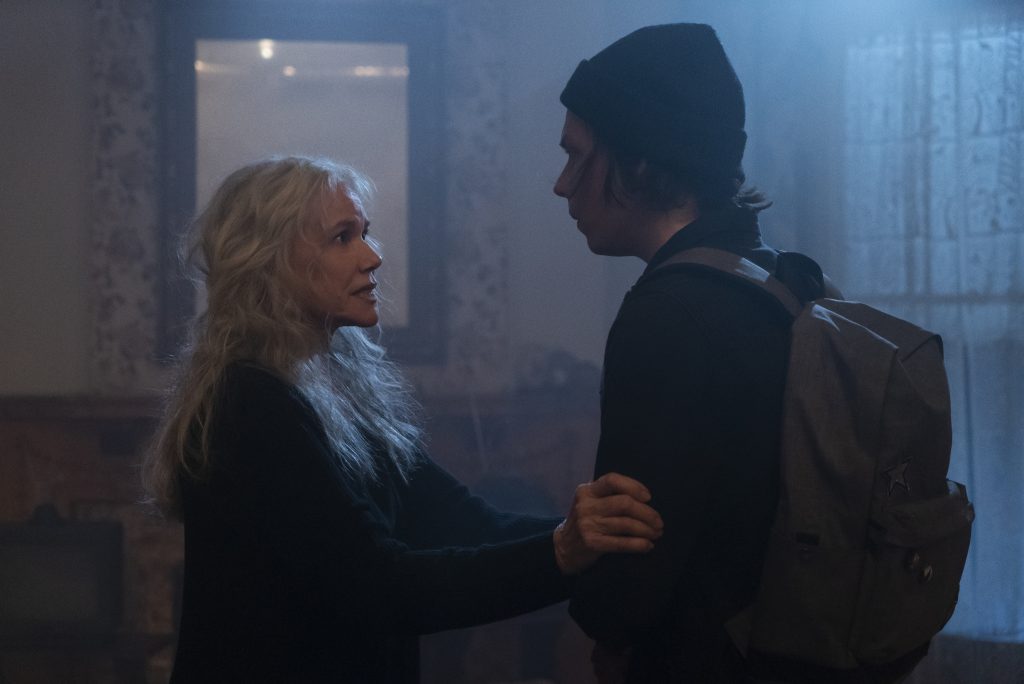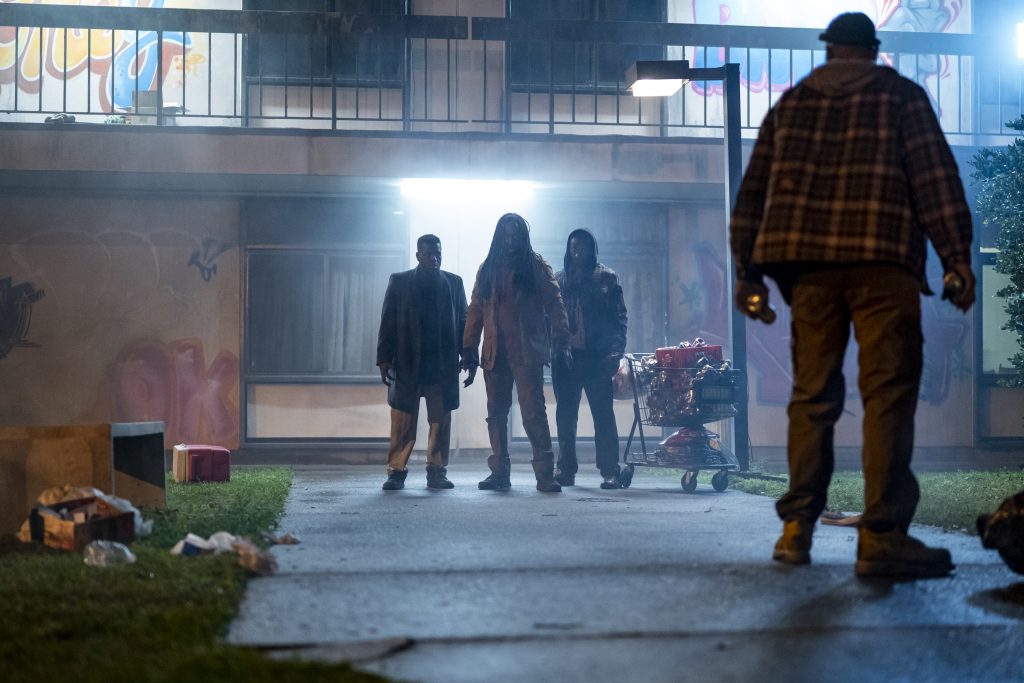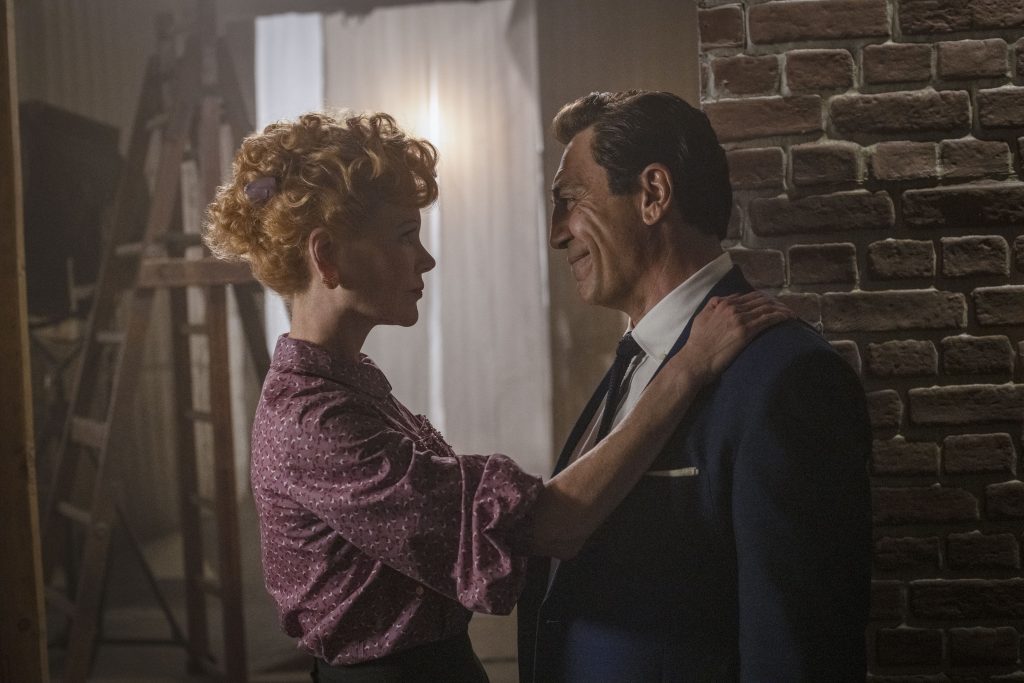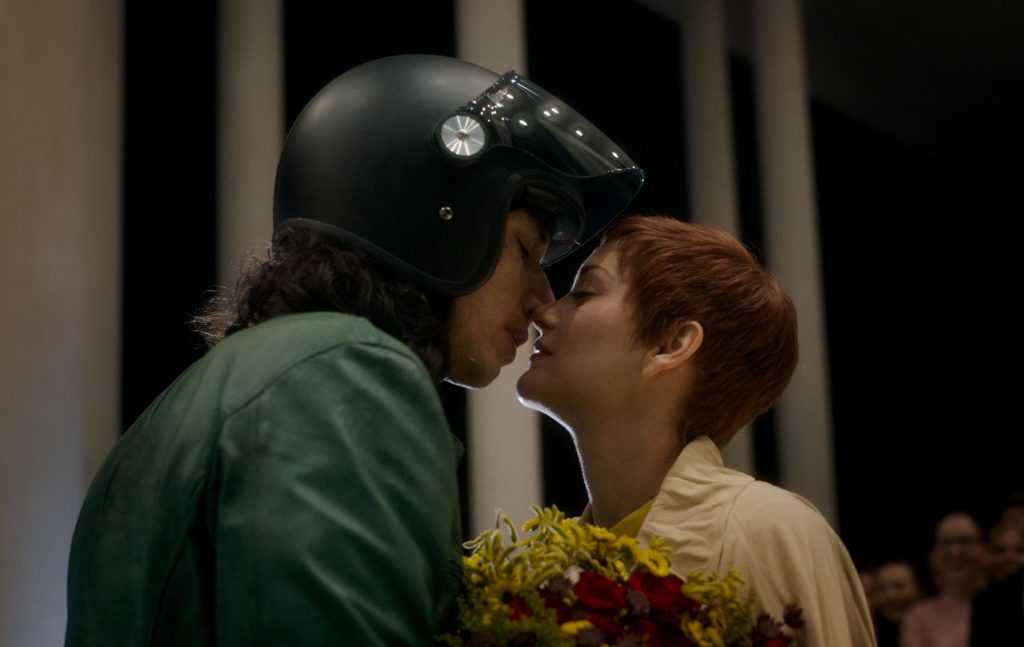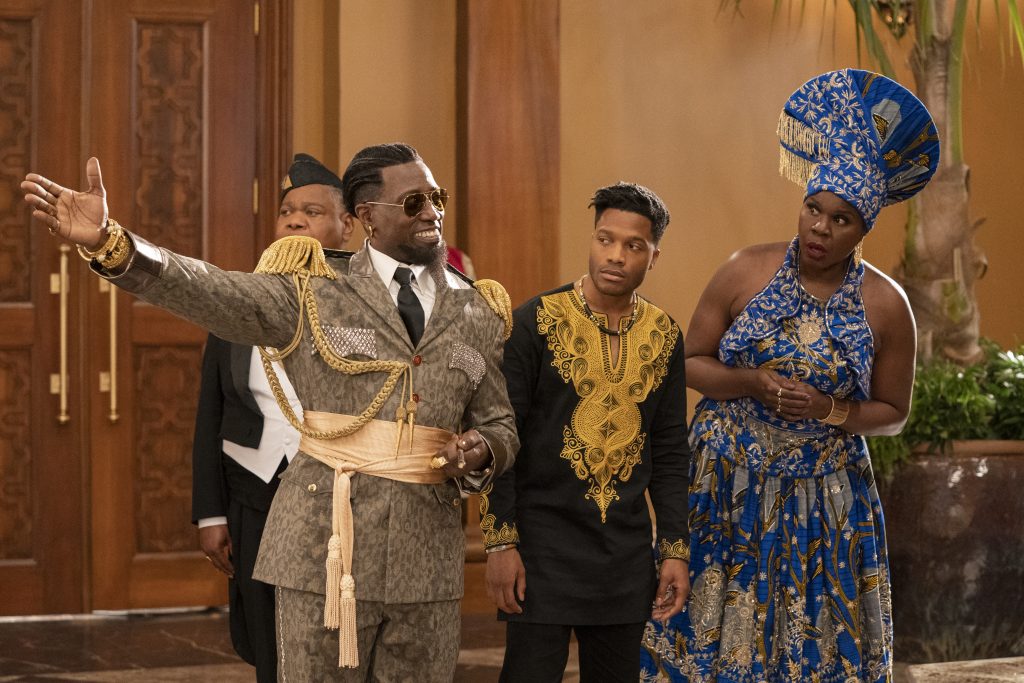January 21, 2022
by Carla Hay
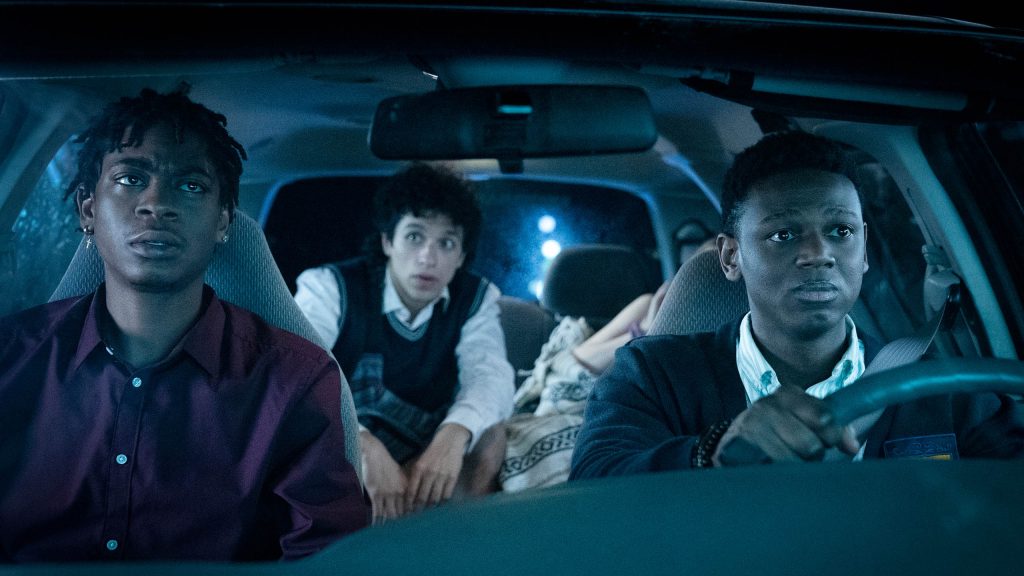
Directed by Carey Williams
Culture Representation: Taking place in an unnamed city on the East Coast of the U.S., the comedy film “Emergency” features a cast of African American and white characters (with a few Latinos) representing the working-class and middle-class.
Culture Clash: After planning a night of partying on their college campus, two African American best friends and their Latino roommate have their plans go awry when they find an extremely intoxicated and barely conscious young white female in their house, and the pals have conflicts over what do about this problem.
Culture Audience: “Emergency” will appeal mainly to people who are interested in movies about misadventures of college partiers, but with themes of racial tension and how it affects people’s perspectives of dealing with law enforcement.
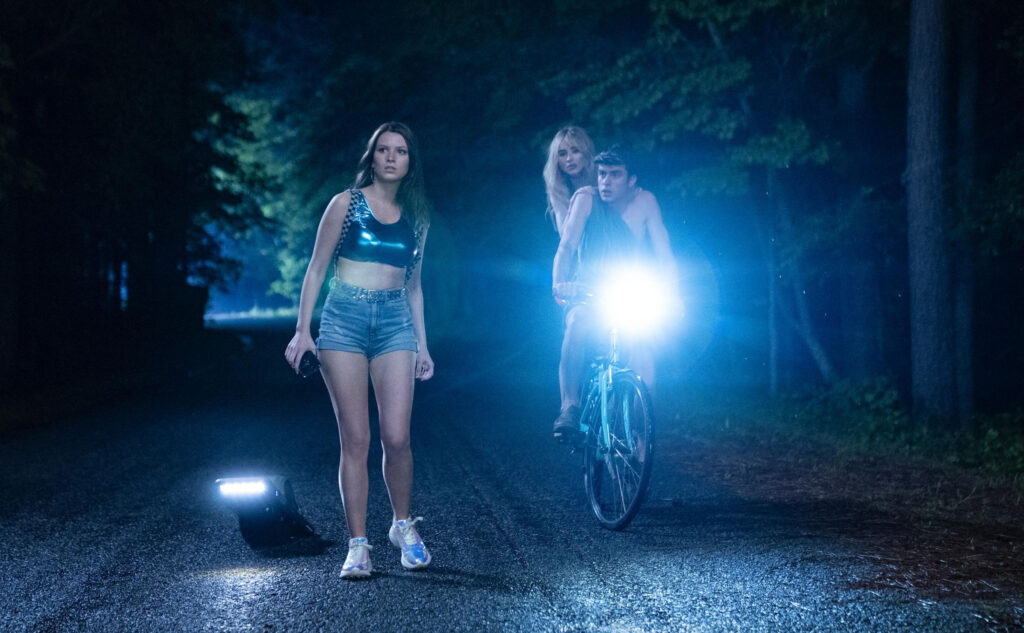
“Emergency” repeats a familiar comedy formula of male partiers getting into a big mess on one wild night, but there’s a Black Lives Matter spin on all the shenanigans. The movie’s heavy emotional turn toward the end makes it better than the average comedy about partiers caught up in a big problem, but some movie clichés still remain. Directed by Carey Williams and written by KD Davila, “Emergency” is likely to find an enthusiastic audience of supporters because the movie centers on characters who rarely get to be the lead characters in movies: black male college students. “Emergency” had its world premiere at the 2022 Sundance Film Festival.
“Emergency” opens with the introduction of the two best friends whose partying plans go haywire over fears that they’ll be wrongfully accused of a crime because they are African American. The two pals are undergraduate students in their last year at the fictional Buchanan University, which is in an unnamed city on the East Coast of the U.S. (“Emergency” was actually filmed in New York state.) Kunle, pronounced “kun-lay” (played by Donald Elise Watkins), is a straight-laced, straight-A student majoring in biology and has plans to go to graduate school at Princeton University. Sean (played by RJ Cyler) is a rebellious stoner with a vaping habit and no plans after he graduates. Sean’s college major is not mentioned in the movie.
Kunle and Sean are ready to party one weekend night in the spring, and they want to make it legendary. The university’s Black Student Union headquarters has a “hall of fame” wall displaying commemorative portrait plaques of black students at the school who were the first to achieve something at the university. For example, there are plaques for the first black student to be the school’s newspaper editor, or the first black student to be student government president. “Emergency” pokes fun of this “first black student” tribute wall by also having plaques for trivial things, such as the first black student to use 3-D printing.
Sean and Kunle want to get on the “hall of fame” wall as the first black students to do the Legendary Tour. What is the Legendary Tour? It’s a tour of seven major campus parties happening on the same night, for one night of the year. The parties are invitation-only with distributed passes, and it’s extremely difficult for anyone to score passes for all seven parties.
Not surprisingly, party-loving Sean is the one who’s more caught up than Kunle is in reaching this Legendary Tour goal. Sean is the one who goes to the trouble of getting all the passes that he and Kunle need to complete the Legendary Tour. Kunle goes along with these plans, but he has other things on his mind. He has to complete a very important scientific lab project as part of his thesis required for graduation. The lab project includes meticulous examination and storage of bacteria cultures.
On the day of the Legendary Tour, Sean and Kunle talk about their upcoming party plans and their love lives. Sean has an ex-girlfriend named Asa (played by Summer Madison), another Buchanan University student, who’s done with Sean, but he might not be completely over his feelings for her. Kunle is romantically unattached too, but he has a crush on another student named Bianca (played by Gillian Rabin), who’s in at least one class with Sean and Kunle. Sean, who can be rude and crude, says in typical Sean speak when he and Kunle talk about Bianca: “She wants your dick, bro.”
The movie has only one classroom scene, near the beginning of the film. It appears to be a sociology class, where a white British instructor named Professor Clarke (played by Nadine Lewington) says that the topic of the day is hate speech. Sean, Kunle and Bianca are among the students in the class. Not surprisingly, the first word that Professor Clarke wants to discuss is the “n” word, which she says repeatedly, as if she enjoys saying it out loud and knows she’s allowed to say it in this academic context. “What makes this word so powerful?” Professor Clarke asks the students.
Even though the professor reminded the students that this topic of hate speech comes with a trigger warning, and the students signed forms acknowledging that they might hear offensive words during this hate speech topic, Sean whispers to Kunle during the class that he’s still offended. Sean gripes to Kunle: “Why is she teaching a class that she knows nothing about?” Professor Clarke then sees Sean and Kunle talking, and she singles them out to answer questions about the “n” word, which makes Sean even more offended. However, he doesn’t voice his concerns to the professor.
Outside, after the class ends, Sean continues to rant about how Professor Clarke said the “n” word many times in class. Kunle understands both sides of the issue, but he’s also annoyed that Sean is complaining about it to him, not the professor. Kunle reminds Sean that he could’ve said something to the professor about being offended, but Sean didn’t.
Sean’s response is to say: “We got one rule that we ask for white people to respect: ‘Thou shalt not say that one word.’ But they don’t like for us to tell them what to do, so they find loopholes.”
Kunle is more willing to give Professor Clarke the benefit of the doubt by saying she probably didn’t mean any offense. It’s the first sign in the movie that Sean and Kunle have different views of race relations between black people and white people in America. Those differing opinions cause conflicts later on in the movie, which eventually shows if any opinions of the two friends change after their crazy night.
“Emergency” doesn’t go into details over how Sean and Kunle met or how long they’ve been friends, but they’ve been friends since at least their first year at Buchanan University. Conversations in the movie drop some details indicating that Kunle and Sean come from very different family backgrounds. Viewers can see these contrasting backgrounds also shape Sean’s and Kunle’s different perspectives of life as an African American man.
Kunle (who appears to be an only child, since he doesn’t mention any siblings) has parents who are doctors and African immigrants. Kunle is also somewhat of a mama’s boy, since there’s a scene where he talks to his overprotective mother (voiced by Ebbe Bassey) on the phone. There’s a scene later in the movie where Kunle and Sean have a big argument, and Kunle implies that he’s smarter than Sean and has a brighter future because Kunle had a “better” upbringing than Sean.
Sean doesn’t mention his parents, but he comes from a less privileged background where members of his family have had entanglements with police. At one point in the movie, Sean mentions an unarmed cousin who was shot in the rear end by a cop. And there’s another scene in the movie that takes place in the home of Sean’s older brother Terence (played by Robert Hamilton III), who doesn’t want to get involved in Sean’s problems because Terence is on parole for an unnamed reason. It’s hinted in this conversation that Sean has also gotten into trouble with the law in the past, but the movie doesn’t go into any details.
Sean and Kunle live together in an on-campus house with a third student, who’s also in his last year at Buchanan. His name is Carlos (played by Sebastian Chacon), and he’s a nerdy pothead who desperately wants to be accepted by Sean and Kunle to be their close friend. Carlos, who’s an aspiring mechanical aerospace engineer, spends a lot of time by himself smoking marijuana and playing video games. Kunle treats Carlos with more tolerance than Sean does. Sean thinks Carlos is very corny, immature and weird. Carlos wears a fanny pack and likes to offer granola bars to people as a way to try to make friends.
This friendship dynamic is a formula that’s been used in several other comedy films about male buddies who go out for a night of partying: Two best friends—one who’s mild-mannered and polite, the other who is cocky and foul-mouthed—end up with a “third wheel” pal/acquaintance who’s an eccentric misfit. Examples include 2007’s “Superbad,” 2009’s “The Hangover” and Hulu’s 2020 silly stoner comedy “The Binge.” You can also go all the way back to “Three Stooges” movies to find this formula. “Emergency” stands out because all three of the men happen to be people of color.
Sean has meticulously mapped out his and Kunle’s plans for the Legendary Tour, including the order in which they’ll go to each party and what they’ll be doing at each party. Even though Carlos wants to party with Sean and Kunle, Sean doesn’t want Carlos tagging along because he thinks Carlos is too much of a dork. Sean and Kunle plan to take Sean’s car for their night of debauchery. Kunle drinks alcohol but doesn’t do drugs, while Sean gives the impression that he’s up for doing any kind of drug that comes his way. Sean is drunk and stoned throughout most of the movie.
Things start to go wrong on the night of the Legendary Tour when Sean and Kunle are all set to go to the first stop on tour, and Kunle remembers that he accidentally forgot to properly refrigerate his lab bacteria cultures. In a panic, he tells Sean that if the cultures are ruined, his thesis will be ruined too, and he won’t be able to graduate. Kunle is also worried that messing up this assignment will hurt his chances of going to Princeton.
Sean doesn’t want to go to the parties without Kunle, so he agrees to go with Kunle to take care of this problem. It’s a detour that will delay their partying for about 15 to 20 minutes, so Sean is slightly annoyed but willing to go along with this change of plans. Before they go to the lab, Sean and Kunle have to stop off at their house to get the lab keys. And that’s when things get crazy.
Soon after arriving in the house, Sean and Kunle notice that the front door is unlocked. And on the living room floor is a white teenage girl, dressed in a pink mini-skirt outfit and barely conscious. She’s so intoxicated that she can barely talk, so getting any information from her is useless. The teenager has no purse or ID on her either. And then she starts vomiting, for the first of several times in the movie.
A panicked Sean and Kunle go in Carlos’ room to find out what’s going on and who this mystery girl is, but Carlos has locked himself in his room, getting stoned and playing video games. Carlos doesn’t know who the teenager is and how she got into the house. Carlos is blamed for not knowing how this teenage girl got into the house when he was home, so he’s pressured into helping fix this problem.
Kunle’s first thought is to call 911, but Sean adamantly refuses because he’s certain that because they’re three young men of color in a house with an unconscious white female, they will automatically be blamed for a crime. There’s some back-and-forth arguing over what to do. Kunle hates Sean’s idea to secretly drop the teenager off at a nearby party, but Kunle agrees to the idea that they should anonymously bring her to a hospital.
Of course, there would be no “Emergency” movie if things went according to these friends’ plans. Sean, Kunle and Carlos put the mystery girl in the back of Sean’s car, as they drive to the nearest hospital. What they don’t know yet, but the audience finds out early on, is that her name is Emma (played by Maddie Nichols), and she’s the younger sister of a Buchanan student named Maddy (played by Sabrina Carpenter), who now knows that Emma is missing and is frantically looking for her.
Maddy invited Emma to hang out with her for some campus partying but lost track of Emma. Maddy doesn’t want to call the police to report Emma missing because Maddy is drunk and doesn’t want to get in trouble for underage drinking. And so, Maddy enlists the help of her level-headed friend Alice (played by Madison Thompson) and Alice’s love interest Rafael (played by Diego Abraham) to find Emma. Luckily, Emma has a Find My app on her phone, so that Maddy, Alice and Rafael can track the general area of where she is.
This phone tracking is crucial to a lot of the twists and turns in “Emergency,” but there are still a few plot holes where viewers have to suspend some disbelief. The biggest plot hole is that Maddy didn’t call Emma’s phone while looking for Emma. Maddy sends texts instead. If Maddy had called the phone, then Sean, Kunle and Carlos would’ve heard the phone ringing and found out right away that Emma had a phone, and none of this mess would’ve happened. And where exactly was Emma’s phone? Why were Sean, Kunle and Carlos not able to see it? Those questions are answered in the last third of the movie.
“Emergency” has a few contrivances to ramp up the comedy, such as Maddy, Alice and Raphael only having a bicycle and a hoverboard to get around for transportation. A running joke in the film is that Maddy (who’s too drunk to operate anything that moves) has to be stuck on the back of the bike, while whoever is operating the bike has to work extra hard to pedal the bike because of the extra weight. The movie makes a point of depicting Maddy as a very quick-tempered, bossy and entitled person.
If Maddy is afraid of getting busted by police for underage drinking, Sean is afraid of getting killed by police, just for being a black man in the wrong place at the wrong time. Sean repeatedly warns Kunle that it could happen to them. And so, there’s a scene where Sean and Kunle try to find white or Asian friends who can call 911 for them. Even though this scene is supposed to be hilarious, there’s some biting truth in how the scene comments on racial disparities between how law enforcement treats black people compared to other races.
“Emergency” also pokes fun at the hypocrisy of white people who claim to support the Black Lives Matter movement but are quick to assume that black people are criminals. This happens in a scene in a quiet suburban neighborhood where Emma has to be taken into some shrubbery so that she can urinate. A suspicious white couple (played by Melanie Jeffcoat and James Healy Jr.) in a nearby house see Sean sitting in his car alone on the street outside the house while this is going on. You can easily guess what happens from there, because the movie makes the point that if Sean had been white, this suspicious couple might have had a very different reaction. Ironically, there’s a Black Lives Matter sign on this couple’s lawn.
“Emergency” has a lot to say about race relations, racism and how they are affected by people’s perceptions and interactions with law enforcement. Even though it’s a fictional movie, it brings up many uncomfortable truths about how people are treated and see the world differently because of racial inequalities. Some viewers might laugh at how “paranoid” Sean acts throughout the entire movie. But sadly, his outlook is the reality of many people.
As a comedy, the movie has some slapstick ridiculousness and it tends to over-rely on gross-out vomit gags, but all of it doesn’t undermine the movie’s message. Cyler and Watkins are a dynamic duo in how they portray this realistic friendship. Their emotional moments that come later in the movie are well-acted and have a resonance that goes deeper than a typical comedy film. Chacon is quite good in his role as a sweet-natured misfit, while Carpenter plays her “entitled princess” role to the hilt.
Is “Emergency” a perfect movie? No. For a movie that’s supposed to be about life from an African American perspective, “Emergency” gives very little screen time or importance to African American women. Sean’s ex-girlfriend Asa is the movie’s only black female character who has more than one scene, but she’s in the movie for less than 10 minutes. In one of her brief appearances, Asa says to Sean about Kunle: “Don’t go dragging him into your bullshit. That boy is Black Excellence.”
“Emergency” is so focused on the pain and pressure that black men get from racism, it fails to mention or show that black women share this burden too. In fact, the Black Lives Matter movement was started by African American women. Filmmakers need to be more mindful of how black women are depicted in movies like “Emergency,” because these filmmakers can be guilty of the same sidelining of black women that happens in so-called “racially insensitive” and “racist” movies.
Despite these flaws in the movie, “Emergency” skillfully blends comedy with some of the serious issues presented in the film. The cast members also elevate the material, which could have been mishandled if the cast members weren’t talented. Sean is the flashiest character in “Emergency,” but the movie wants audiences to pay the most attention to Kunle’s perspective and how Kunle is affected by what he goes through in this story.
UPDATE: Amazon Studios will release “Emergency” in select U.S. cinemas on May 20, 2022. Prime Video will premiere the movie on May 27, 2022.





